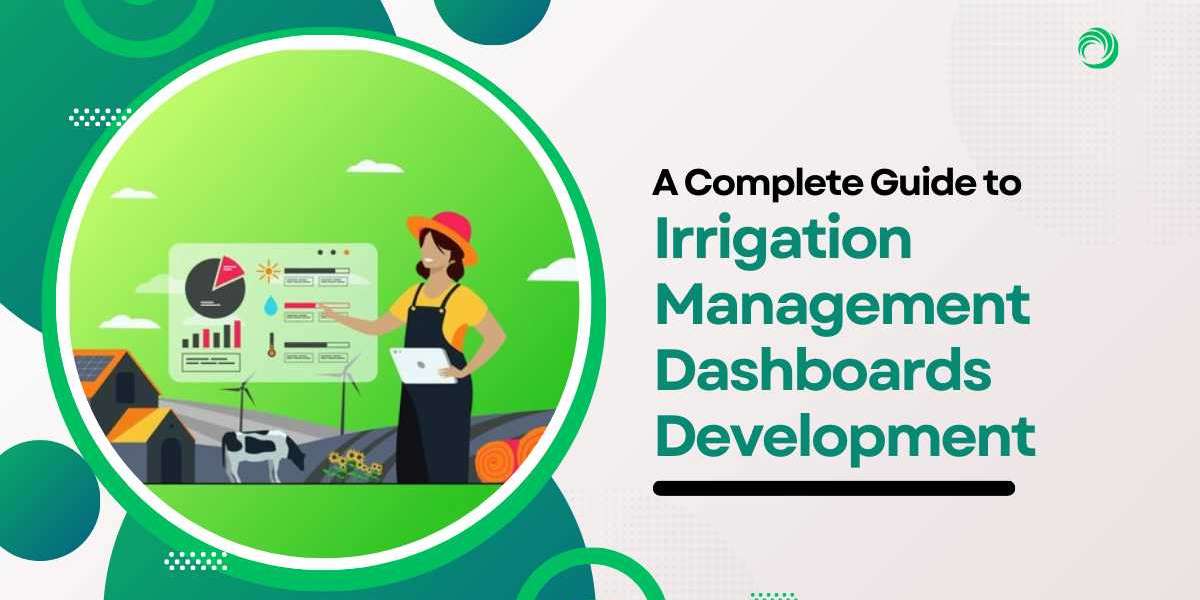Efficient water management is essential for sustainable agriculture, especially in regions facing water scarcity. An Irrigation Management System is designed to optimize water usage, ensuring crops receive the necessary water without wastage. However, managing irrigation systems manually can be complex. That's where Irrigation Management Dashboards Development comes into play. These dashboards offer real-time monitoring and control, making irrigation systems more intelligent, user-friendly, and efficient.
This guide will explore the process of developing irrigation management dashboards, the technical considerations involved, and their benefits to modern agriculture.
Importance of Irrigation Management Systems
An Irrigation Management System helps farmers and agricultural businesses efficiently manage water resources. In 2024, around 70% of freshwater consumption is attributed to agriculture, making efficient irrigation a critical aspect of global water conservation efforts.
Key Benefits of an Irrigation Management System:
- Water Efficiency: Minimizes water wastage by delivering precise amounts based on real-time data.
- Cost Savings: Reduces the cost associated with water usage and energy consumption.
- Automation: Automatically adjusts irrigation schedules based on weather, soil moisture, and crop needs.
- Environmental Impact: Helps in reducing the environmental footprint by lowering water consumption and preventing soil erosion.
What is an Irrigation Management Dashboard?
An Irrigation Management Dashboard is a user-friendly interface that allows farmers and irrigation managers to monitor and control irrigation systems in real-time. It integrates with IoT devices, sensors, and software platforms to provide actionable insights. The dashboard simplifies decision-making by displaying data like soil moisture levels, weather forecasts, and irrigation schedules in an easy-to-read format.
Key Features of an Irrigation Management Dashboard:
- Real-time Data Monitoring: Displays data from sensors monitoring soil moisture, temperature, and humidity.
- Weather Forecast Integration: Adjusts irrigation schedules based on real-time weather data.
- Remote Control: Allows users to control irrigation systems from any location via mobile or web applications.
- Analytics and Reporting: Provides detailed reports and analytics to help optimize water usage and crop yield.
Core Components of Irrigation Management Dashboards Development
Developing an irrigation management dashboard involves multiple technical components, including hardware (sensors, controllers) and software (data processing, user interface). Let's explore the essential elements of Irrigation Management Dashboards Development.
1. IoT Sensors and Devices
IoT sensors are crucial for gathering data in an Irrigation Management System. Sensors placed in fields measure various parameters:
- Soil Moisture Sensors: Measure the moisture content in the soil.
- Weather Stations: Record data like temperature, humidity, and rainfall.
- Flow Meters: Track the amount of water used for irrigation.
These sensors communicate the data to the dashboard in real time. Using wireless technologies such as LoRaWAN or cellular networks ensures uninterrupted data transmission.
2. Data Processing and Analytics
The data collected from IoT sensors is processed in real-time using cloud platforms or on-premise servers. The processing pipeline typically involves:
- Data Collection: Gathering data from sensors and external sources (weather APIs, satellite data).
- Data Analysis: Analyzing the data to detect patterns, such as soil moisture trends or rainfall probabilities.
- Actionable Insights: The system generates insights, such as when and where irrigation is needed.
For example, if the soil moisture falls below a certain threshold, the dashboard can automatically trigger irrigation, saving water and optimizing crop growth.
3. User Interface and Dashboard Design
The user interface (UI) is critical for presenting complex data in an easy-to-understand format. When designing the dashboard, several factors should be considered:
- Data Visualization: Use graphs, charts, and maps to visualize data like soil moisture levels, irrigation schedules, and water usage.
- Customizable Layouts: Allow users to personalize their dashboard to prioritize the most relevant information.
- Mobile Compatibility: Ensure the dashboard is accessible via mobile devices, enabling remote management.
A well-designed dashboard allows users to make informed decisions quickly, which is vital in fast-paced agricultural environments.
4. Integration with Existing Systems
Many farmers already use various tools to manage crops, water systems, and farm equipment. The irrigation management dashboard should integrate seamlessly with:
- Farm Management Systems: Synchronize data with farm management software for better crop and water planning.
- Weather APIs: Fetch real-time weather data for precise irrigation scheduling.
- Automation Controllers: Work with smart irrigation controllers that automate water distribution based on the dashboard's insights.
5. Automation and Control
Automation is a key feature in an Irrigation Management System. Once the dashboard processes the data, it can automate specific tasks:
- Automatic Valve Control: Open or close irrigation valves based on soil moisture readings.
- Scheduled Irrigation: Set irrigation schedules based on predefined parameters like crop type, soil type, and weather conditions.
- Notifications and Alerts: Send notifications to users if abnormal conditions are detected, such as water leaks or equipment malfunctions.
Challenges in Developing Irrigation Management Dashboards
Developing a robust irrigation management dashboard involves tackling several challenges, particularly in data accuracy, network connectivity, and user experience.
1. Data Accuracy
Accurate data is essential for the effective functioning of an irrigation system. However, sensor malfunctions, network issues, or environmental factors can lead to inaccurate readings. To overcome this:
- Calibrate Sensors Regularly: Ensure all sensors are properly calibrated for accurate readings.
- Implement Data Validation: Use algorithms to cross-check data with historical records or neighboring sensors to detect anomalies.
2. Network Connectivity
Reliable connectivity is crucial for real-time monitoring and control. In remote agricultural areas, internet access can be unreliable, which affects data transmission. Solutions include:
- Use Low-Power Wide-Area Networks (LPWAN): Technologies like LoRaWAN or Sigfox enable long-range, low-power data transmission, ideal for large agricultural fields.
- Edge Computing: Process data locally on edge devices to reduce dependency on cloud connectivity.
3. User Experience
Farmers and irrigation managers may not always be tech-savvy. Therefore, developing an intuitive and easy-to-use dashboard is crucial. Consider:
- Simplified Controls: Use straightforward controls for irrigation scheduling and system adjustments.
- Clear Visuals: Ensure data visualizations are easily understandable.
- Multilingual Support: Provide options for users to operate the dashboard in different languages, catering to a global audience.
Benefits of Irrigation Management Dashboards for Agriculture
Developing an efficient Irrigation Management System offers numerous benefits for farmers and agricultural enterprises. Let's explore the key advantages.
1. Water Conservation
A well-designed dashboard optimizes water usage by ensuring irrigation only occurs when necessary. This can lead to significant water savings, especially in drought-prone areas. A study by the Food and Agriculture Organization (FAO) found that smart irrigation systems could reduce water usage by up to 30%.
2. Increased Crop Yield
With precise water delivery based on real-time data, crops receive the optimal amount of water, leading to healthier growth and higher yields. Data-driven irrigation can result in up to a 20% increase in crop productivity.
3. Cost Savings
By automating irrigation schedules and controlling water usage, farmers save on labor costs and water expenses. Additionally, optimizing energy usage for irrigation pumps reduces overall operational costs.
4. Sustainability
An efficient irrigation system reduces water waste, energy consumption, and the risk of over-irrigation, contributing to more sustainable agricultural practices. This aligns with global efforts to combat climate change and water shortages.
Example of a Successful Irrigation Management Dashboard
The Netafim Automated Irrigation System is a leading example of successful irrigation management. Netafim's dashboard allows farmers to monitor water usage, soil conditions, and weather patterns in real-time. The system has led to a 15% reduction in water usage and a 10% increase in crop yield for users.
Conclusion
The development of Irrigation Management Dashboards is transforming agriculture by enabling smarter, more efficient irrigation practices. These systems offer significant benefits, including water conservation, cost savings, and increased crop yields. As technology continues to advance, the integration of AI, machine learning, and satellite data will further enhance the capabilities of these dashboards, making them indispensable tools in sustainable farming practices.
By investing in Irrigation Management Dashboards Development, farmers can ensure long-term productivity and resource conservation, helping to meet the challenges posed by climate change and growing global food demands.







